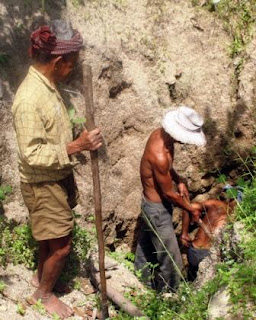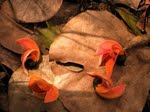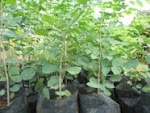Aquamarine!
>> Friday, November 27, 2009
 In a small-scale Cambodian gemstone mining site the predominate stones are quartz (rock and smoky) and topaz, but now we can add aquamarine to the menu of offerings.
In a small-scale Cambodian gemstone mining site the predominate stones are quartz (rock and smoky) and topaz, but now we can add aquamarine to the menu of offerings.Takeo Province, Cambodia, produces not just white and smoky topaz, but also aquamarine.
This week I spent a day at the base of the mountain talking to the gemstone cutters and sellers. And looking at their stones. Especially their gemstone rough (t'bong chau).
Most of these uncut crystals are very clear, though the larger they are, the more likely they are to be included. I looked at the inclusions with my 10X loupe and they exacty what was expected (GIA Gem Handbook).

 All of the crystals in the photo above are Aquamarine, except for the fat stone near the center and on the top of the picture, that is Topaz, typical of what they find in the nearby stream beds. But the most telling point was that many of the uncut crystals are clearly symmetrical six-sided forms; Topaz simply does not grow that way, though some of the sellers persist in selling cut stones which are clearly too light in weight to be Topaz (by my admittedly subjective heft) , as Blue Topaz.
All of the crystals in the photo above are Aquamarine, except for the fat stone near the center and on the top of the picture, that is Topaz, typical of what they find in the nearby stream beds. But the most telling point was that many of the uncut crystals are clearly symmetrical six-sided forms; Topaz simply does not grow that way, though some of the sellers persist in selling cut stones which are clearly too light in weight to be Topaz (by my admittedly subjective heft) , as Blue Topaz.The fewer the inclusions, the smaller the piece of rough. The clearest stones -- and some of the crystals are flawless -- the thinner they are. There are two results: first, the thin small stones are cut into rectangular step-cuts (like an emerald, its 'cousin', might be) and second, the larger crystals with their large inclusions and breaks are carved into Khmer or Chinese Buddhas.
My whole plan to get two pieces of cut gemstone, one Topaz, the other a blue stone of the same carat weight foundered abruptly. (I wanted to see if the Topaz was smaller in volume).
 The sellers do not own even the simplest of means to weigh their stones. They seem to estimate by eye the size of the stone and distinguish between them only on the basis of clarity, color if any, and type of stone, before they set their price. And my plan to buy some cut blue Aquamarine (and make tens of dollars)? That plan foundered also: any of stones available with significant color were visibly included. The brilliant, cut white (clear) Topaz is actually amazingly cheap; easy to see why it has been mistaken for diamonds. The sellers say that they are attracting a lot of visitors from Hanoi and from Ho Chi Minh City. They are well positioned to do that, the mountain is only half an hour from the border.
The sellers do not own even the simplest of means to weigh their stones. They seem to estimate by eye the size of the stone and distinguish between them only on the basis of clarity, color if any, and type of stone, before they set their price. And my plan to buy some cut blue Aquamarine (and make tens of dollars)? That plan foundered also: any of stones available with significant color were visibly included. The brilliant, cut white (clear) Topaz is actually amazingly cheap; easy to see why it has been mistaken for diamonds. The sellers say that they are attracting a lot of visitors from Hanoi and from Ho Chi Minh City. They are well positioned to do that, the mountain is only half an hour from the border.
If you visit, remember: this is a culture that bargains. With the slightest pressure the sellers will drop 25% to 30% off of their marked price (just ask: "Som joh damlei bantic baan tee?" Can you please lower the price just a little?" And if that is a bit too much (my phonetization surely leaves much to be desired), just wave your hand, palm down, in a downward direction, pointing at the price, with a suitable modest and calm look on your face (Cambodians do not know how to react to anger or outrage or righteous indignation even if feigned (I don't know if they even do indignation, never seen it, or the signs are not accessible to foreigners :).
And at the end, say: "Awgun! (Thank you)" They will really appreciate the effort.
The fact is buying a gem from a poor Cambodian dealer is not just about getting a beautiful gemstone at a decent price, but also about walking away, thinking: what a nice lady, that was fun! :)
Read more...
 The sellers do not own even the simplest of means to weigh their stones. They seem to estimate by eye the size of the stone and distinguish between them only on the basis of clarity, color if any, and type of stone, before they set their price. And my plan to buy some cut blue Aquamarine (and make tens of dollars)? That plan foundered also: any of stones available with significant color were visibly included. The brilliant, cut white (clear) Topaz is actually amazingly cheap; easy to see why it has been mistaken for diamonds. The sellers say that they are attracting a lot of visitors from Hanoi and from Ho Chi Minh City. They are well positioned to do that, the mountain is only half an hour from the border.
The sellers do not own even the simplest of means to weigh their stones. They seem to estimate by eye the size of the stone and distinguish between them only on the basis of clarity, color if any, and type of stone, before they set their price. And my plan to buy some cut blue Aquamarine (and make tens of dollars)? That plan foundered also: any of stones available with significant color were visibly included. The brilliant, cut white (clear) Topaz is actually amazingly cheap; easy to see why it has been mistaken for diamonds. The sellers say that they are attracting a lot of visitors from Hanoi and from Ho Chi Minh City. They are well positioned to do that, the mountain is only half an hour from the border.If you visit, remember: this is a culture that bargains. With the slightest pressure the sellers will drop 25% to 30% off of their marked price (just ask: "Som joh damlei bantic baan tee?" Can you please lower the price just a little?" And if that is a bit too much (my phonetization surely leaves much to be desired), just wave your hand, palm down, in a downward direction, pointing at the price, with a suitable modest and calm look on your face (Cambodians do not know how to react to anger or outrage or righteous indignation even if feigned (I don't know if they even do indignation, never seen it, or the signs are not accessible to foreigners :).
And at the end, say: "Awgun! (Thank you)" They will really appreciate the effort.
The fact is buying a gem from a poor Cambodian dealer is not just about getting a beautiful gemstone at a decent price, but also about walking away, thinking: what a nice lady, that was fun! :)





























